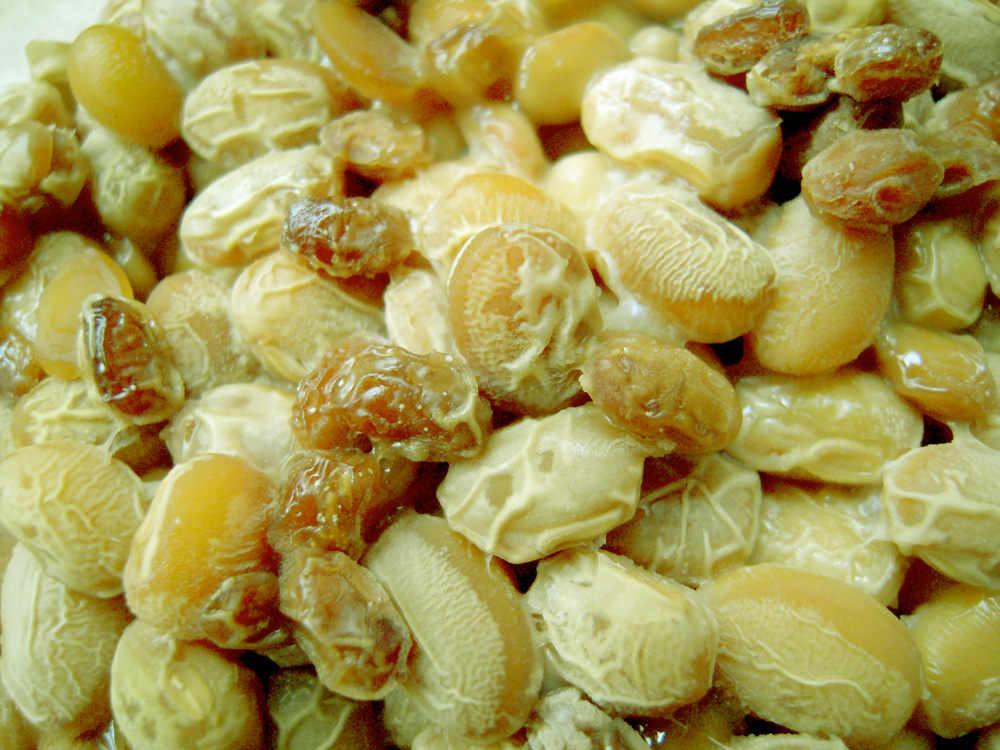
Natto is the one of those foods that elicits strong reactions. I get overwhelmed with a sense of joy and excitement, but the response I hear from most people (who aren't from or aren't descendants of the eastern regions of Japan) is pure disgust.
I remember how clueless I was junior year in college when I stocked up on natto and brought it back to my fridge that I shared with four other UC Santa Cruzers. As I was innocently devouring a package of natto, my roommate barged in yelling "Oh my god! What is that smell?!" My answer to her was, "Are you talking about your pet rat?" as I gestured my chopsticks (all stringy with natto strands) to point at the corner of the room where her pet rat resided. She shook her head and inched in closer to me to inspect the contents of my bowl.
It never registered to me that cold food could smell -- and up until that point, I never suspected that natto even had a smell.
That was my first lesson in how natto could offend people. From that day forward, I could not eat natto so long as I lived with roommates.
Natto is fermented soybeans that were traditionally made in
kotatsus in Japanese homes in the Kanto (Tokyo) region. It's like yogurt in the way that you start with a culture. In the case of natto, the culture used is bacillus subtilis and the medium is soybeans which are left in a humid, warm environment for 24 hours. The result is a mixture of stringy, luscious soybeans that are kind of like a soft cheese in texture with an aroma like no other. Some describe it like smelly French cheese... while my roommates told me it smelled like feet.
Natto is getting some attention because of its health benefits. Eastern regions of Japan have less incidence of osteoporosis. Plus, that sticky stuff apparently contains some enzymes that thin the blood, therefore, preventing heart attacks, strokes and certain types of cancers. I guess they even sell natto in pill form and call it "Nattokinase" here in the west.
My love for natto was evident from my early days -- soon after I exited the womb. But our bond strengthened exponentially when I moved to Tokyo where I could indulge in my love for it with no shame or judgment from my peers. Plus they were regularly priced at a dirt-cheap 30-cents a serving. I would eat a package every morning before dashing off to work. It was like my daily cup of coffee.
So when I came back to the U.S. last month, I braced myself for an environment that would challenge my love affair with natto. It's not that expensive here in California at about $2.00 for three servings, but that's still about twice the amount I was used to in Tokyo. Plus, it's not readily available, say at the local 7-11 or Safeway.
I concluded that the only way I could rely on a steady and affordable supply of natto was to make it myself. My experience with making yogurt for four years, gave me the confidence to try my hand at natto as well.
Here's how I made it:
1) Gather together the following ingredients and supplies: 1 lb of soybeans, a store bought pack of natto, water, glass containers, foil
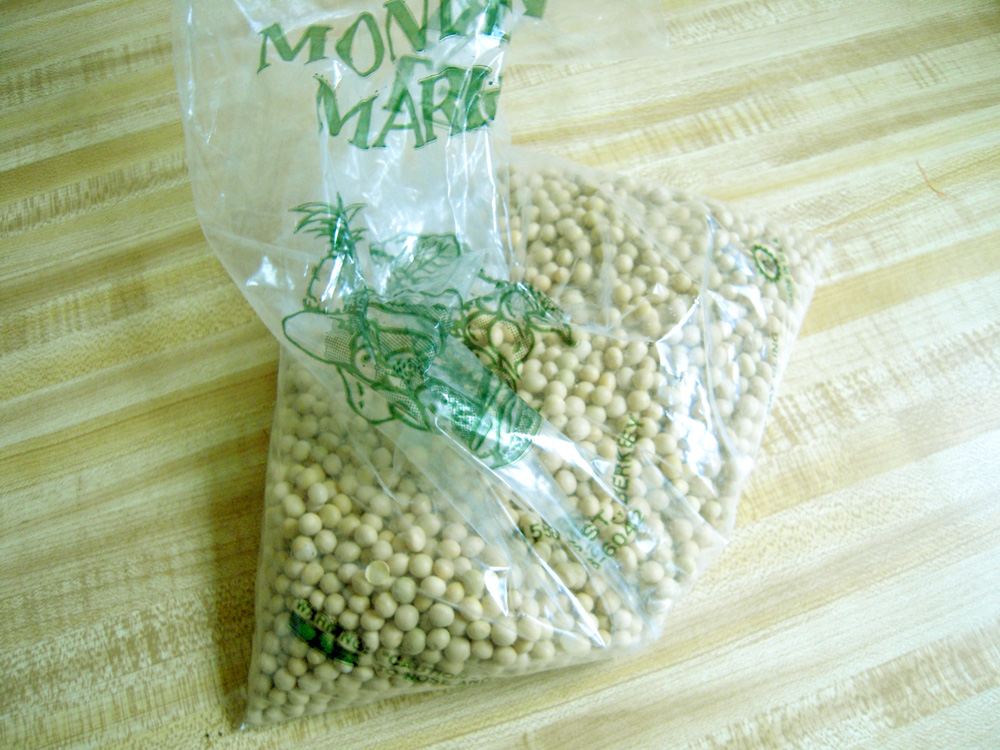
2) Soak soybeans overnight in plenty of water.
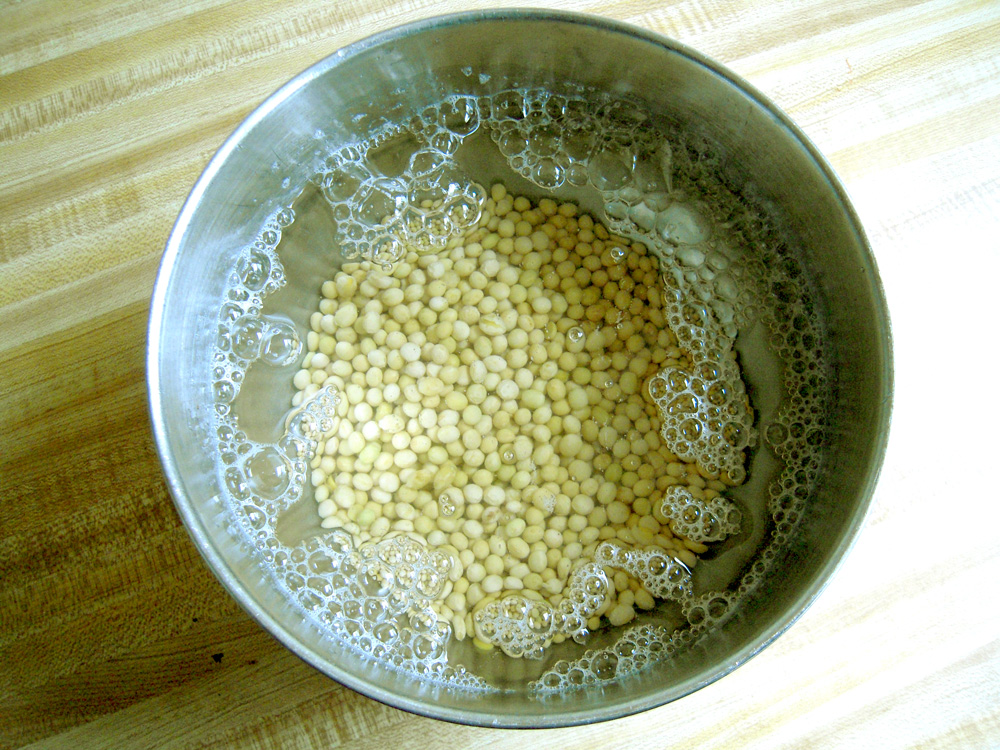
After one night:

3) Drain the soybeans.
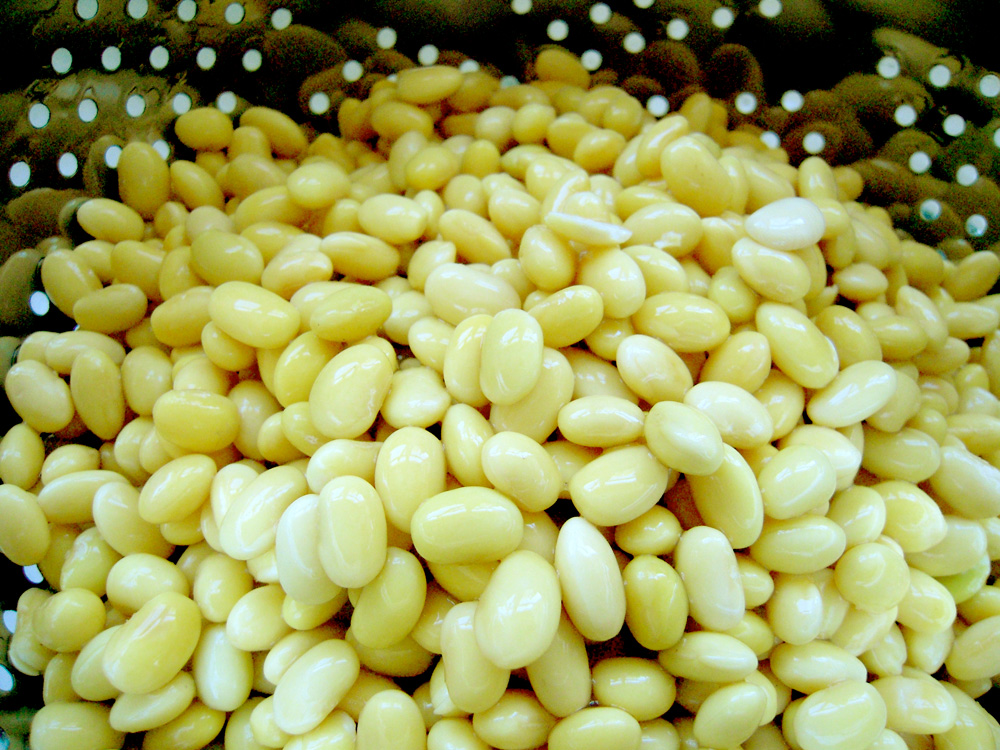
4) Steam the soybeans until you can smush them between your thumb and pointer finger.

I used my rice cooker which also can act as a pressure cooker. I ended up steaming the soybeans for 40 minutes.
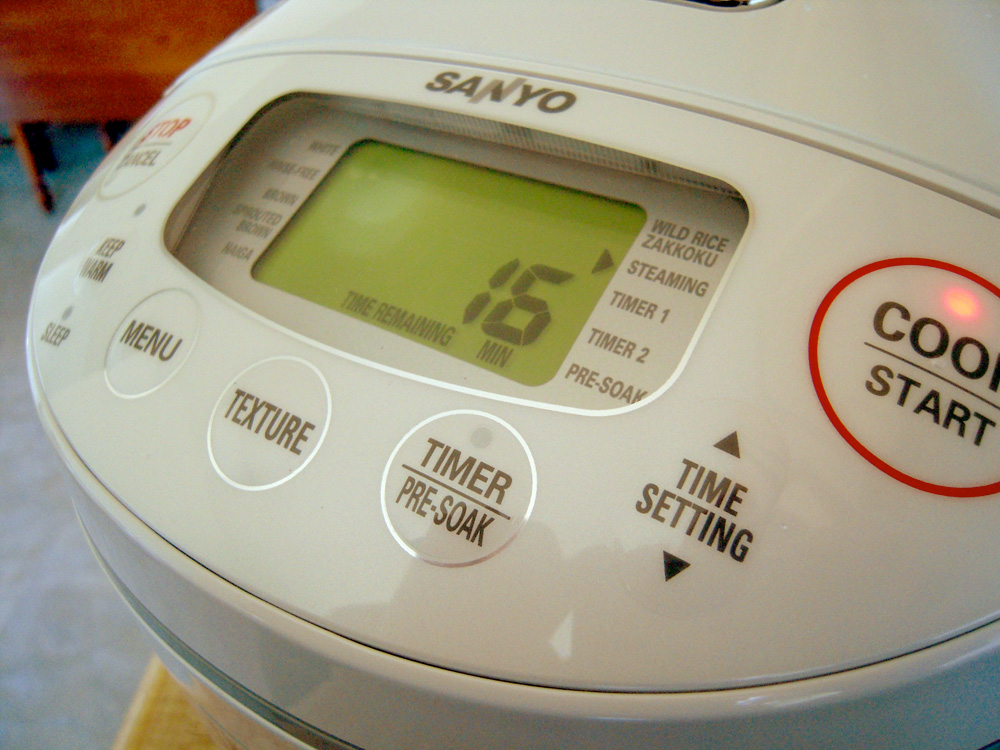
5) While the soybeans are steaming, sterilize the glass containers you will use to ferment the soybeans in. I set my oven to 250 degrees and placed my glass containers in there for about 30 minutes.

6) Break out the store-bought package of natto.
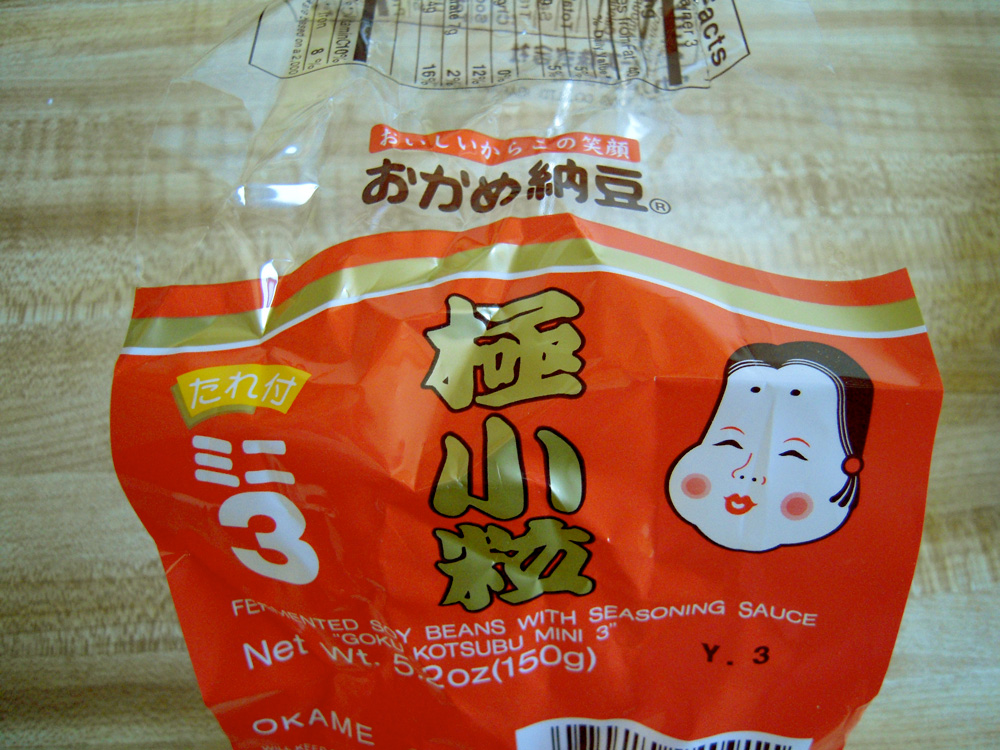
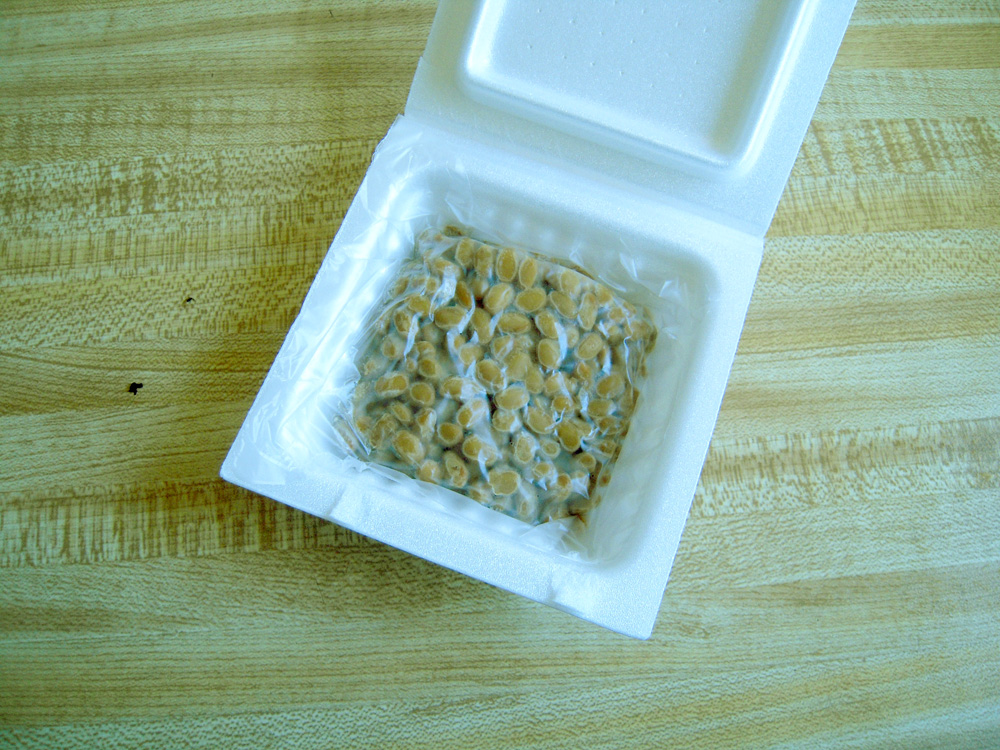
7) Once the soybeans are done steaming, combine them with the store-bought package of natto.
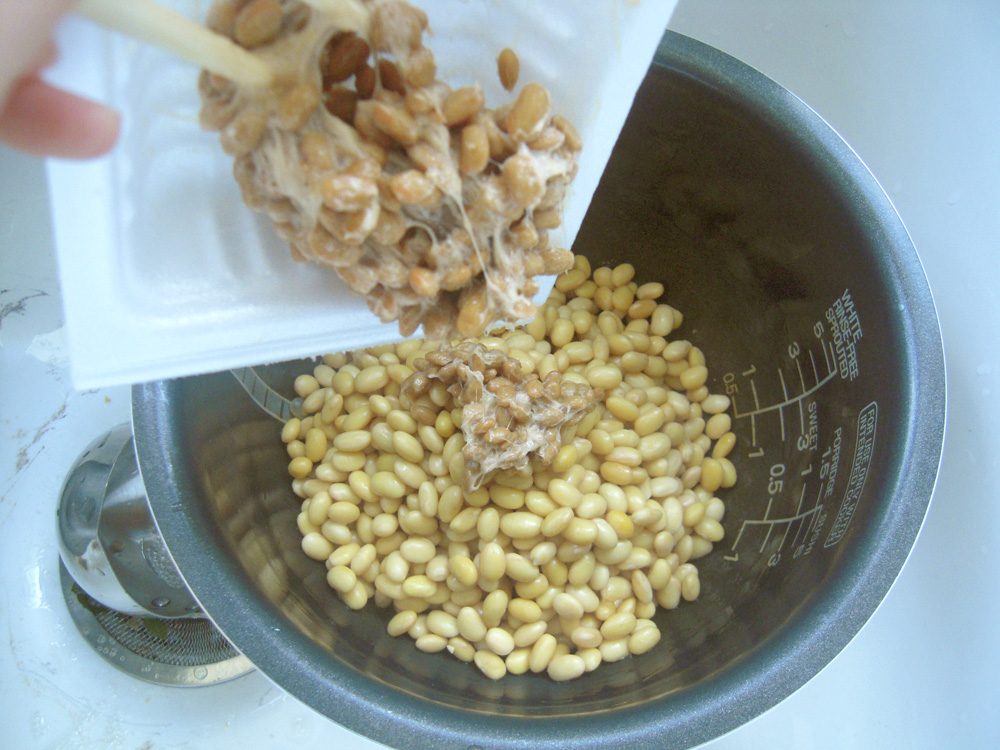
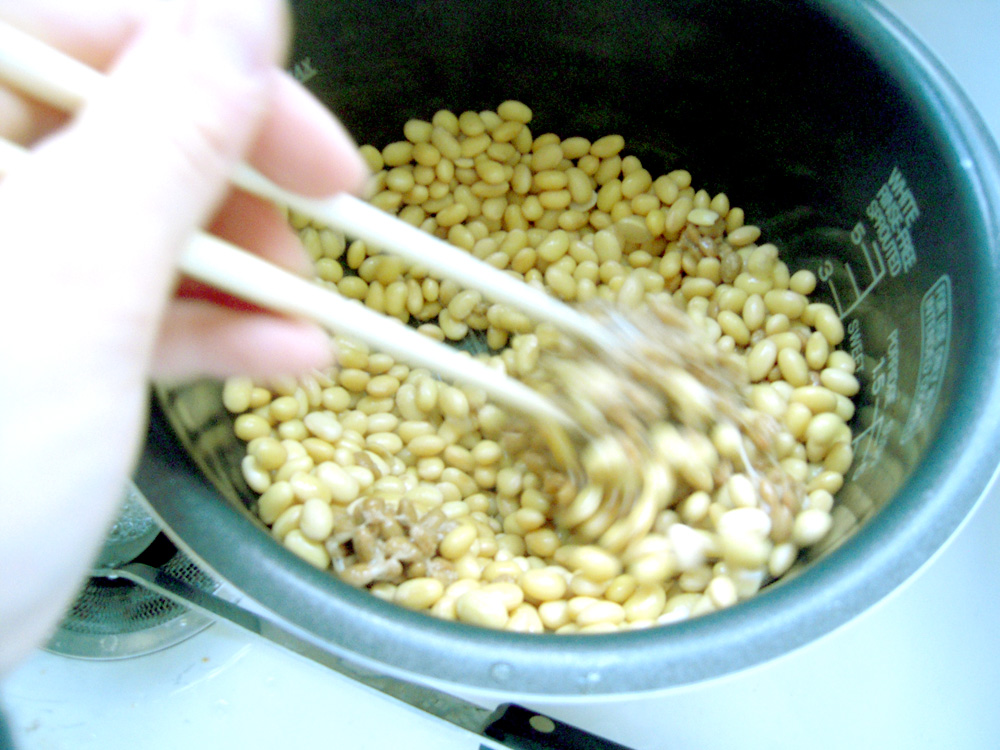
8) Mix well then place the beans into the sterilized jars. Cover the jars with aluminum foil. Poke holes in the foil so that the soybeans can "breathe" during the fermentation process.
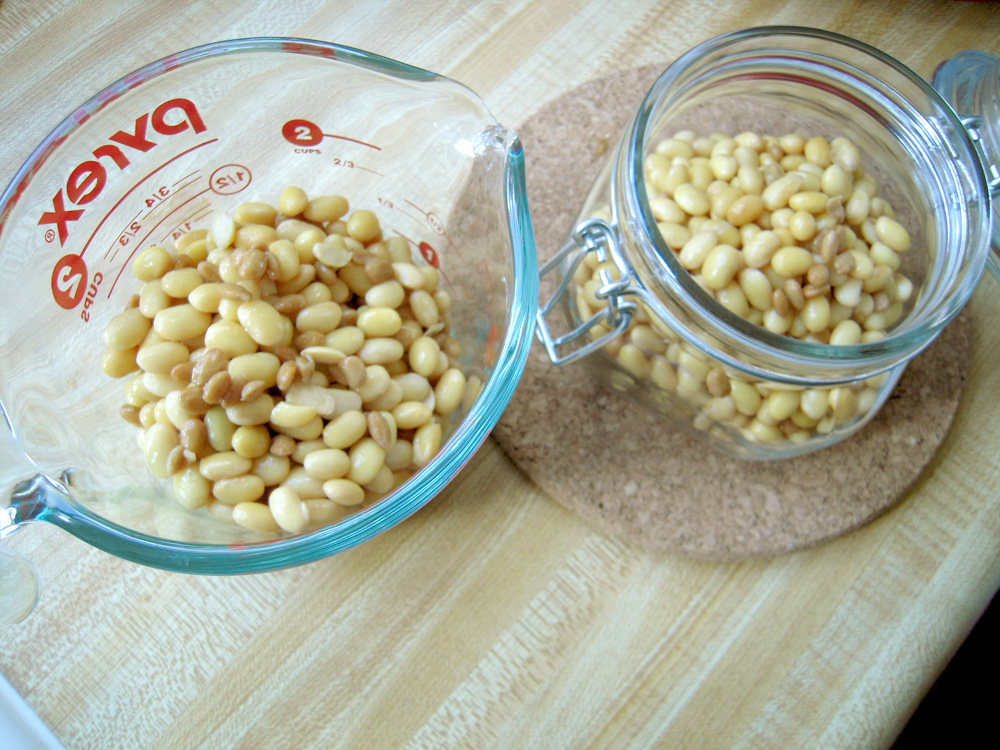

9) Okay, the beans are now ready to ferment. The basic idea for creating an ideal environment is to keep the beans in a humid, warm climate at about 40 degrees celsius (think mid-August Tokyo in a small room on the fourth floor with no windows and air conditioning). So I decided to keep the jars in my Crock-pot filled with a little bit of water on the "warm" setting. People also seem to use ice boxes filled with hot water bottles.
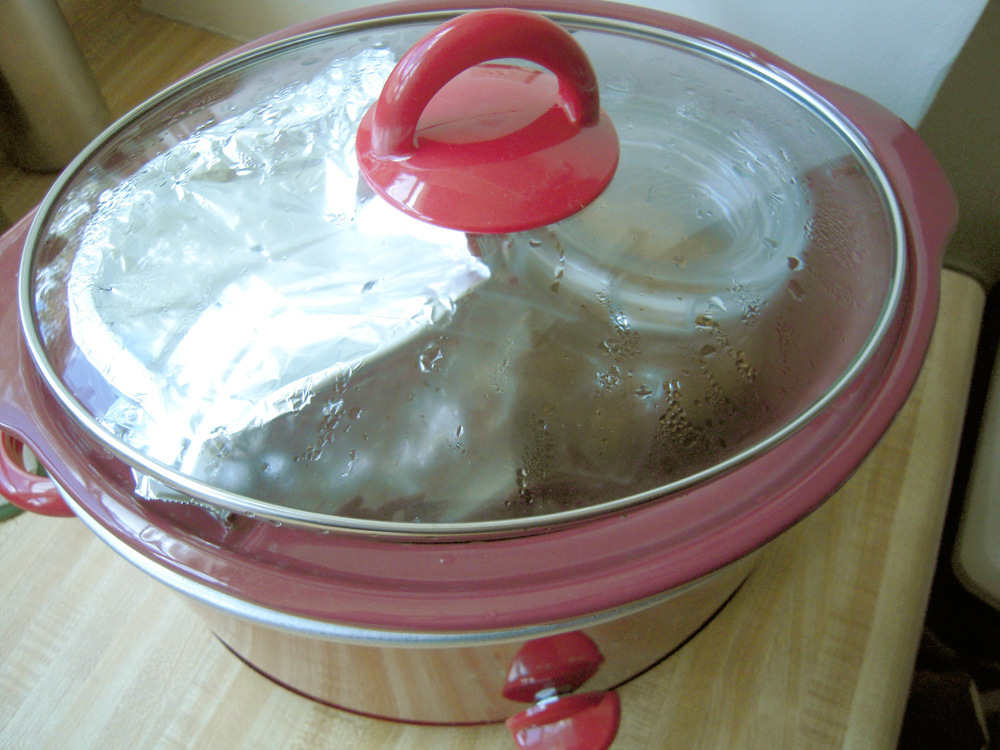
10) Wait for 24 hours.
The suspense got the best of me and I took a peek inside after 12 hours:

And the next morning they really seemed all mature and grown up.

Look at the stringiness!!! I was a very proud parent.
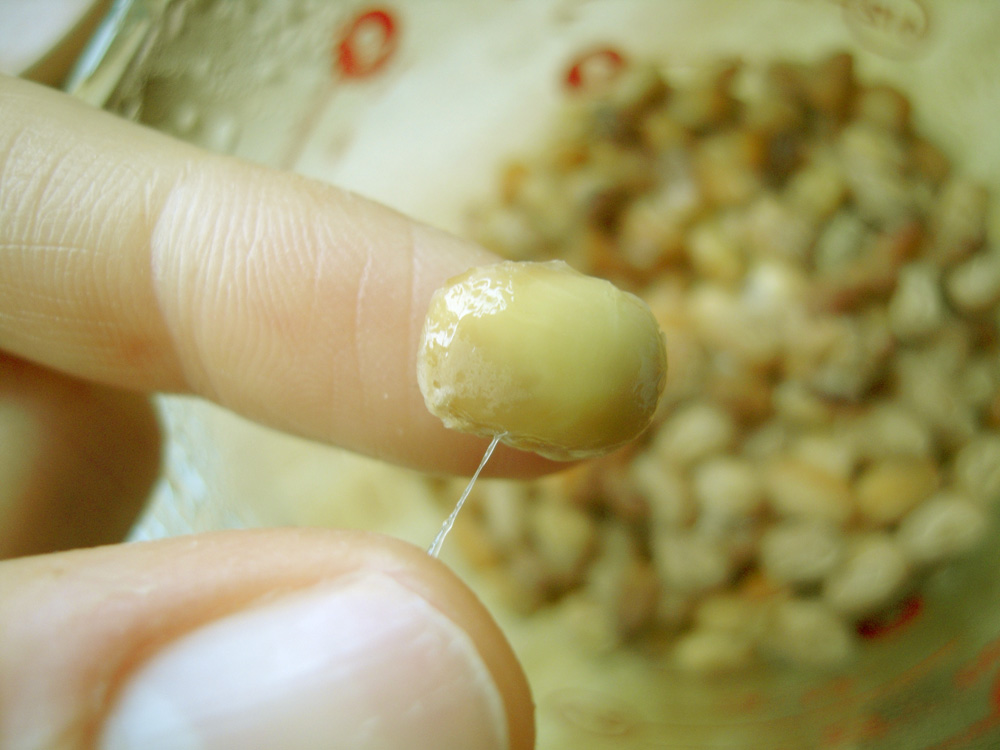
11) But the wait was not over. These beads of joy must be aged for umami in air-tight containers for a few days to one week in the refrigerator.
12) I finally got to indulge today over rice and I experienced a deep sense of pride and accomplishment. With a dash of soy sauce and Japanese mustard mixed into my home-made natto, I knew I had achieved nirvana for my taste buds and wallet.
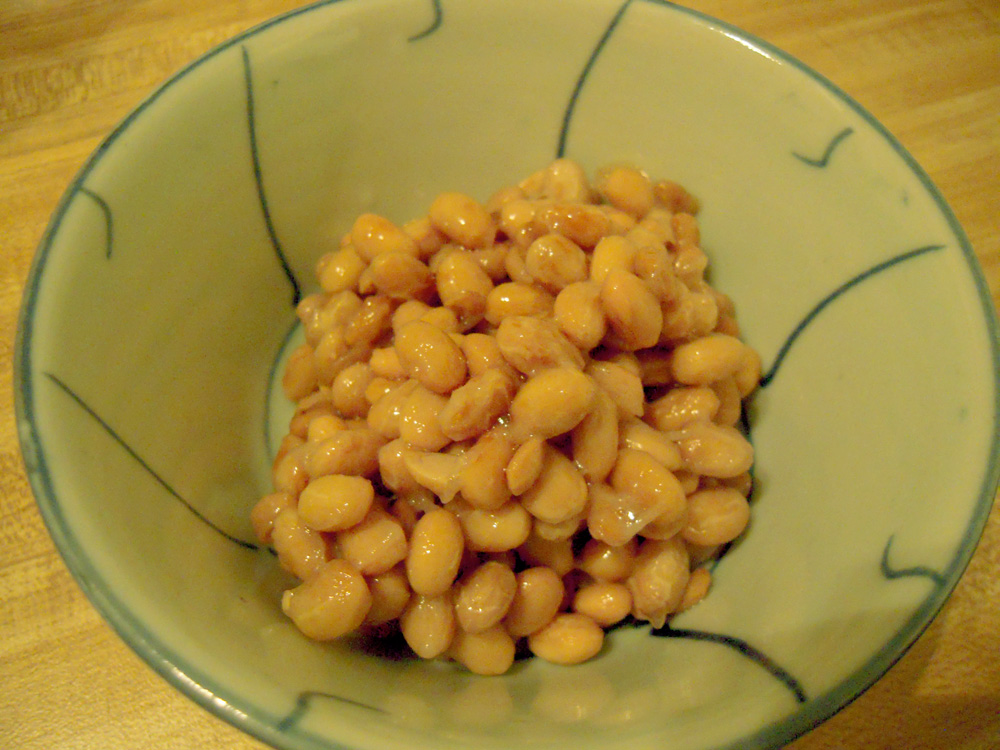

13) To complete the cycle, freeze a portion of the natto to use as the starter for the next batch of natto.
 Natto is the one of those foods that elicits strong reactions. I get overwhelmed with a sense of joy and excitement, but the response I hear from most people (who aren't from or aren't descendants of the eastern regions of Japan) is pure disgust.
I remember how clueless I was junior year in college when I stocked up on natto and brought it back to my fridge that I shared with four other UC Santa Cruzers. As I was innocently devouring a package of natto, my roommate barged in yelling "Oh my god! What is that smell?!" My answer to her was, "Are you talking about your pet rat?" as I gestured my chopsticks (all stringy with natto strands) to point at the corner of the room where her pet rat resided. She shook her head and inched in closer to me to inspect the contents of my bowl.
It never registered to me that cold food could smell -- and up until that point, I never suspected that natto even had a smell.
That was my first lesson in how natto could offend people. From that day forward, I could not eat natto so long as I lived with roommates.
Natto is fermented soybeans that were traditionally made in kotatsus in Japanese homes in the Kanto (Tokyo) region. It's like yogurt in the way that you start with a culture. In the case of natto, the culture used is bacillus subtilis and the medium is soybeans which are left in a humid, warm environment for 24 hours. The result is a mixture of stringy, luscious soybeans that are kind of like a soft cheese in texture with an aroma like no other. Some describe it like smelly French cheese... while my roommates told me it smelled like feet.
Natto is getting some attention because of its health benefits. Eastern regions of Japan have less incidence of osteoporosis. Plus, that sticky stuff apparently contains some enzymes that thin the blood, therefore, preventing heart attacks, strokes and certain types of cancers. I guess they even sell natto in pill form and call it "Nattokinase" here in the west.
My love for natto was evident from my early days -- soon after I exited the womb. But our bond strengthened exponentially when I moved to Tokyo where I could indulge in my love for it with no shame or judgment from my peers. Plus they were regularly priced at a dirt-cheap 30-cents a serving. I would eat a package every morning before dashing off to work. It was like my daily cup of coffee.
So when I came back to the U.S. last month, I braced myself for an environment that would challenge my love affair with natto. It's not that expensive here in California at about $2.00 for three servings, but that's still about twice the amount I was used to in Tokyo. Plus, it's not readily available, say at the local 7-11 or Safeway.
I concluded that the only way I could rely on a steady and affordable supply of natto was to make it myself. My experience with making yogurt for four years, gave me the confidence to try my hand at natto as well.
Here's how I made it:
1) Gather together the following ingredients and supplies: 1 lb of soybeans, a store bought pack of natto, water, glass containers, foil
Natto is the one of those foods that elicits strong reactions. I get overwhelmed with a sense of joy and excitement, but the response I hear from most people (who aren't from or aren't descendants of the eastern regions of Japan) is pure disgust.
I remember how clueless I was junior year in college when I stocked up on natto and brought it back to my fridge that I shared with four other UC Santa Cruzers. As I was innocently devouring a package of natto, my roommate barged in yelling "Oh my god! What is that smell?!" My answer to her was, "Are you talking about your pet rat?" as I gestured my chopsticks (all stringy with natto strands) to point at the corner of the room where her pet rat resided. She shook her head and inched in closer to me to inspect the contents of my bowl.
It never registered to me that cold food could smell -- and up until that point, I never suspected that natto even had a smell.
That was my first lesson in how natto could offend people. From that day forward, I could not eat natto so long as I lived with roommates.
Natto is fermented soybeans that were traditionally made in kotatsus in Japanese homes in the Kanto (Tokyo) region. It's like yogurt in the way that you start with a culture. In the case of natto, the culture used is bacillus subtilis and the medium is soybeans which are left in a humid, warm environment for 24 hours. The result is a mixture of stringy, luscious soybeans that are kind of like a soft cheese in texture with an aroma like no other. Some describe it like smelly French cheese... while my roommates told me it smelled like feet.
Natto is getting some attention because of its health benefits. Eastern regions of Japan have less incidence of osteoporosis. Plus, that sticky stuff apparently contains some enzymes that thin the blood, therefore, preventing heart attacks, strokes and certain types of cancers. I guess they even sell natto in pill form and call it "Nattokinase" here in the west.
My love for natto was evident from my early days -- soon after I exited the womb. But our bond strengthened exponentially when I moved to Tokyo where I could indulge in my love for it with no shame or judgment from my peers. Plus they were regularly priced at a dirt-cheap 30-cents a serving. I would eat a package every morning before dashing off to work. It was like my daily cup of coffee.
So when I came back to the U.S. last month, I braced myself for an environment that would challenge my love affair with natto. It's not that expensive here in California at about $2.00 for three servings, but that's still about twice the amount I was used to in Tokyo. Plus, it's not readily available, say at the local 7-11 or Safeway.
I concluded that the only way I could rely on a steady and affordable supply of natto was to make it myself. My experience with making yogurt for four years, gave me the confidence to try my hand at natto as well.
Here's how I made it:
1) Gather together the following ingredients and supplies: 1 lb of soybeans, a store bought pack of natto, water, glass containers, foil
 2) Soak soybeans overnight in plenty of water.
2) Soak soybeans overnight in plenty of water.
 After one night:
After one night:
 3) Drain the soybeans.
3) Drain the soybeans.
 4) Steam the soybeans until you can smush them between your thumb and pointer finger.
4) Steam the soybeans until you can smush them between your thumb and pointer finger.
 I used my rice cooker which also can act as a pressure cooker. I ended up steaming the soybeans for 40 minutes.
I used my rice cooker which also can act as a pressure cooker. I ended up steaming the soybeans for 40 minutes.
 5) While the soybeans are steaming, sterilize the glass containers you will use to ferment the soybeans in. I set my oven to 250 degrees and placed my glass containers in there for about 30 minutes.
5) While the soybeans are steaming, sterilize the glass containers you will use to ferment the soybeans in. I set my oven to 250 degrees and placed my glass containers in there for about 30 minutes.
 6) Break out the store-bought package of natto.
6) Break out the store-bought package of natto.

 7) Once the soybeans are done steaming, combine them with the store-bought package of natto.
7) Once the soybeans are done steaming, combine them with the store-bought package of natto.

 8) Mix well then place the beans into the sterilized jars. Cover the jars with aluminum foil. Poke holes in the foil so that the soybeans can "breathe" during the fermentation process.
8) Mix well then place the beans into the sterilized jars. Cover the jars with aluminum foil. Poke holes in the foil so that the soybeans can "breathe" during the fermentation process.

 9) Okay, the beans are now ready to ferment. The basic idea for creating an ideal environment is to keep the beans in a humid, warm climate at about 40 degrees celsius (think mid-August Tokyo in a small room on the fourth floor with no windows and air conditioning). So I decided to keep the jars in my Crock-pot filled with a little bit of water on the "warm" setting. People also seem to use ice boxes filled with hot water bottles.
9) Okay, the beans are now ready to ferment. The basic idea for creating an ideal environment is to keep the beans in a humid, warm climate at about 40 degrees celsius (think mid-August Tokyo in a small room on the fourth floor with no windows and air conditioning). So I decided to keep the jars in my Crock-pot filled with a little bit of water on the "warm" setting. People also seem to use ice boxes filled with hot water bottles.
 10) Wait for 24 hours.
The suspense got the best of me and I took a peek inside after 12 hours:
10) Wait for 24 hours.
The suspense got the best of me and I took a peek inside after 12 hours:
 And the next morning they really seemed all mature and grown up.
And the next morning they really seemed all mature and grown up.
 Look at the stringiness!!! I was a very proud parent.
Look at the stringiness!!! I was a very proud parent.
 11) But the wait was not over. These beads of joy must be aged for umami in air-tight containers for a few days to one week in the refrigerator.
12) I finally got to indulge today over rice and I experienced a deep sense of pride and accomplishment. With a dash of soy sauce and Japanese mustard mixed into my home-made natto, I knew I had achieved nirvana for my taste buds and wallet.
11) But the wait was not over. These beads of joy must be aged for umami in air-tight containers for a few days to one week in the refrigerator.
12) I finally got to indulge today over rice and I experienced a deep sense of pride and accomplishment. With a dash of soy sauce and Japanese mustard mixed into my home-made natto, I knew I had achieved nirvana for my taste buds and wallet.

 13) To complete the cycle, freeze a portion of the natto to use as the starter for the next batch of natto.
13) To complete the cycle, freeze a portion of the natto to use as the starter for the next batch of natto.




Comments (52)
Thank you for the Wonderful Detailed Instructions on how to make Natto! I ran into problem trying to figure out how to Incubate my Natto for 24 hours? So, I didn’t want to buy a crockpot to Incubate my Natto? Well, i found a Beautiful Stainless Steel deep pan with lid and an opening, which I decided to use as Incubator? It is perfect and i set my electric stove at Low and i will be watching it for 24 hours. Thank you again. 🌺
This is life-changing!!! Family favorite that ends up taking a lot of my money, and now I can make as much as I want for meals! Thank you so much!
Have you tried just putting the beans straight in the crockpot on warm? If so how did that go?
Excellent presentation and very useful information. To hold a stable fermenting environment, I bought a temperature controller used by home beer brewers (about US$15) & use a 60 watt incandescent lamp, shielded by a tin can with both ends cut out to form a chimney around the lamp, inside a cooler chest. Set the temperature controller for 98 – 100 F. There’s an extra pan of water in the chest to keep the humidity up. If anyone cares,, I’d be happy to send photos.
where can I buy the natto fresh to use for culturing?
Excellent. After several different ways I started doing similar to yours. I made it simpler, I think. After steaming I do put in a ice chest but I place a heating pad in low temp. Leave them for 48 hours. That’s the way I am doing now. Willing to try more different ways to improve. Also, I steam 60 minutes. Used to do 40 minutes. Enjoy Natto! And stay healthy!!
The best description of a doable way to make natto. Thank you, Yoko. Began to use the store bought version $3.99 per in Hawai’i where currently live. Hope to check back and write my results, eventually. Natto is unique, very special, and want to have more than the 1 teaspoon I read contains all the K2 one would need daily. Amounts of K2 are measured in mcg: Natto contains a huge amount – way more than any other source. It also seems to change one’s sensibility – or whatever – meaning that all foods do affect how one feels. Even a very small amount of natto seems to have a positive effect; it’s very subtle.
For those who use the Instant Pot to pressure steam the soybeans, how long do you pressure steam them?
oh this might be the BEST post so far. Good job Yoke!
Thanks! It was really fun to do and write about. I can’t wait to make my next batch.